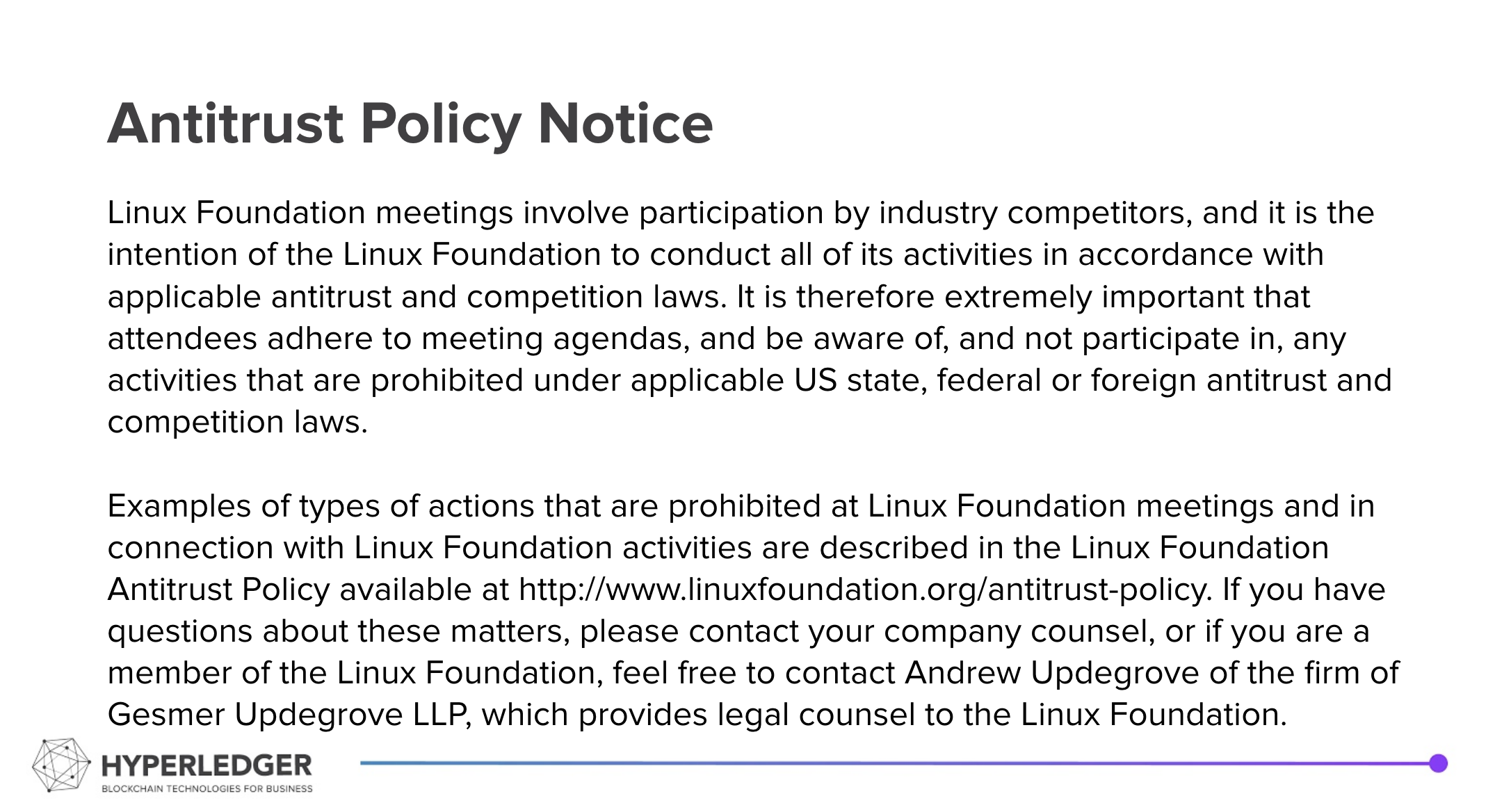Hyperledger is committed to creating a safe and welcoming community for all. For more information please visit the Hyperledger Code of Conduct.
Hyperledger is committed to creating a safe and welcoming community for all. For more information please visit our Code of Conduct: Hyperledger Code of Conduct
Details
Date: Thursday, March 21, 2024
Time: 9:30pm IST / 5:00pm CET / 4:00pm GMT / 12:00pm EST / 9:00am PST
Meeting link: https://zoom.us/my/hyperledger.community.backup?pwd=dkJKdHRlc3dNZEdKR1JYdW40R2pDUT09
Zoom Meeting ID: 622 333 6701 Passcode: 475869
Meeting Recording on YouTube
Upcoming events
- Apr 3-5: NFT-NYC
- Apr 4: Meral Sengoz of T3i Partner Network on Blockchain Experiences for Export Transactions in Turkey
- Apr 16-18: Linux Foundation Open Source Summit North America, Seattle Washington. Includes a "SupplyChainSecurityCon" track.
- Apr 18: Hyperledger Supply Chain & Trade Finance SIG - Farm to Plate
- May 2: Hyperledger Supply Chain & Trade Finance SIG - SIG Member & The Giving Chain CEO Bobbie Muscara will present on how they use NFTs
- May 16 Hyperledger Supply Chain & Trade Finance SIG - Alexander Style of Vinturas
- June 4-5: Freightwaves Future of Supply Chain, Atlanta, GA
Announcements
- Look at the new webinar planning page
Presentation
Ashish Anand of Brú Finance: Tokenized Commodity Finance
Ashish was originally from the finance side of the equity table. He has a background in commodity finance.
Realized in 2016 firms were paying for services with cryptocurrency and the crypto was created through software code.
Bru Finance has two entities,
- Bru Finance is the DeFi entity
- Whrrl which was constructed in 2019
Bru is building the operating system for tokenized commodities. Bru recognized the RWA tokenization wave.
Connecting the real world to the tokenized world through ETFs.
2023 was the year when the tokenized wave arrived. The gold and real estate tokenization wave began in 2022.
Bru Finance is focused on the commodity sector vertical through a buildout of a complete full-stack commodity chain.
Bru launched the 1st tokenized commodity exchange in India.
With commodities as a physical object/asset, they require monitoring throughout the supply chain.
Bru described through a graph the high level of fragmentation are the commodity markets, especially over the past 2 years:
- pricing inefficiencies
- fragmented liquidity
- high price volatility
- supply and price shocks
Bru described the concept of commodity finance. Commodities by their nature are not supply and demand matched. Due to this mismatch,
commodities remain in hand with the producer due to a lack of demand. Therefore, there is a need for a specific type of financing
which is called "Commodity Finance" or "Warehouse Receipt Finance".
Over the past 10 years, every year there has been a loss to lenders of hundreds of millions of dollars due to the risk inherent
within commodity financing. Bru is a solution to these losses by managing risk through blockchain. Blockchains' immutability and
traceability enable a lending institution to know when they are lending against a commodity there is nobody else also lending against
the same commodity in a warehouse. Ensures the commodity collateral is safe.
Bru provided 4 examples of financial firms' losses in commodity financing.
The architecture of the Bru Finance platform:
- Is both a permissioned and permissionless blockchain. Built on Quorum due to its functionality meeting the Bru platform
functional requirements.
- The permissioned portion was constructed first.
- Borrower's devices can be mobile, laptop to interact with the blockchain.
- Consists of a "bridge" between the permissioned and permissionless blockchains.
- Polygon is the "public'/permissionless blockchain component.
- Polygon interacts with ethereum blockchain through L2 to L1 connection.
Bru Finance Process:
- Create a digital twin which ensures the physical commodity is not in circulation and it is in a bonded warehouse.
- The stored physical commodity is verified through a combination of machine and machine learning solutions and human and
oracle audits.
- Commodity producers are certified as KYC(Know Your Customer).
- Take the commodity details(weightage, price, quality) and create a token(NFT) representing ownership.
- The NFT token can be transferred or it can be used as collateral by lenders. Lenders can be Banks or liquidity providers.
- The NFT token can be used within the TradeFi(banks) or DeFi(bonds) markets.
- The permissioned blockchain portion tokenizes the commodity.
- Warehousing, lenders/banks and asset verifiers all brought together on the permissioned blockchain.
How do banks/lenders manage risk associated with commodity price decreases:
- Lending is never 100% of the value of the commodity. It is usually in the range of 60-70%.
- Mark to Market process where if there is a price drop of 5% or greater in the commodity value the borrower is
required to deposit more commodity or pay off a portion of the loan.
- Ability to liquidate the commodity if mark-to-market conditions deem this action.
Risk Management through the Bru Finance platform:
- immutability, tokens can not be duplicated
- lending process is controlled by smart contracts to eliminate double lending against a commodity
- source based custodial level to ensure commodity is in the physical location.
- machine learning solutions to reduce cost and ensure commodity is not moved.
Bru has tokenized $700 million dollars and is the largest tokenized platform in India.
Bru storage capacity under management to 100 million metric tons.
Attendees

